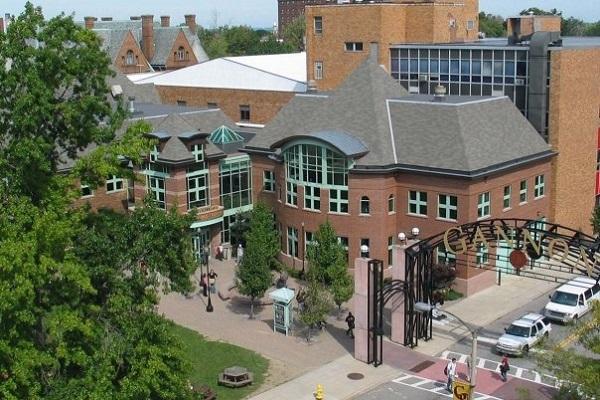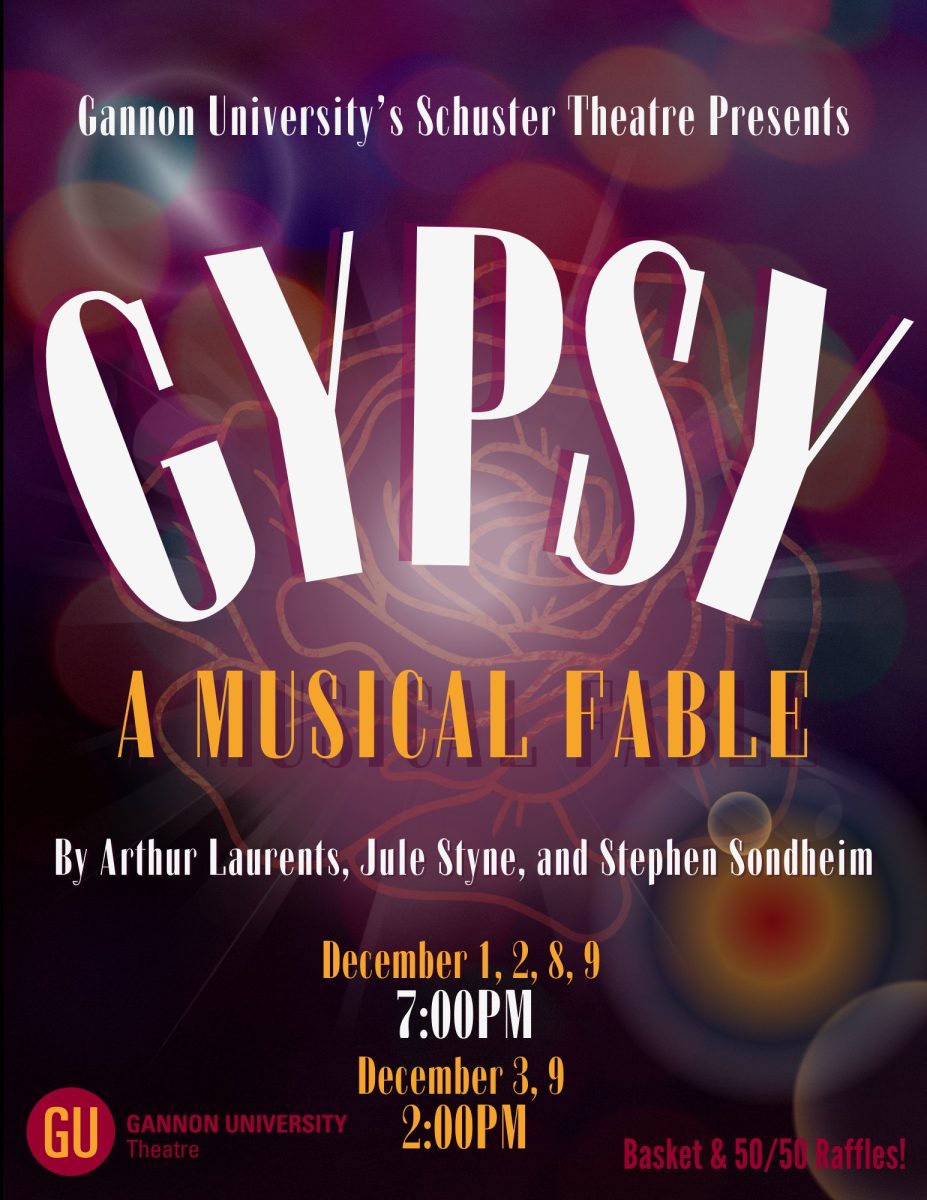Since its beginning as Cathedral College under the 1925 charter of Villa Maria College, Gannon University has continued to expand and grow both physically and academically. The growth began when Archbishop John Mark Gannon purchased one of the most elegant buildings in downtown Erie in 1941. It was then known as the Strong Mansion and is now recognized by the Gannon community as Old Main.
It wasn’t until 1944 that Cathedral College received its own charter and was renamed Gannon College. Gannon was a four-year all-men’s college until 1964 when it became co-educational and established a graduate school. It merged with Villa Maria College in 1969 and 10 years later, the college acquired its university status.
Those 50 years as an institution of higher education were fundamental in steering Gannon in the direction it is headed in now, 90 years later.
Gannon is a private, Catholic, co-educational university and has morphed into a respected university in northwestern Pennsylvania. Located in the heart of downtown Erie, Gannon has had an impact on the city’s growth and development.
According to the erie.pa.us website, Erie has a population of 101,786 and three local universities. Gannon is one of the two private Catholic universities in Erie, Mercyhurst University is the second private Catholic university and Penn State Behrend is a state-related public university. Both universities are different from Gannon because they are not urban campuses. The campuses are enclosed and away from the main streets of Erie.
Being a downtown campus, Gannon has the biggest physical impact on the Erie community. Currently, Gannon has 46 buildings and has plans to continue to purchase property throughout Erie.
Keith Taylor, Ph.D., president of Gannon, said the university is currently implementing its strategic plan to expand the campus and help make Erie a safe, healthy and livable area. He said there are decades of growth and important history in downtown Erie and it has been an exciting time for the university.
Taylor said in the last eight years, Gannon has invested almost $100 million just in facilities in downtown between purchases and renovations. The university will have about another $15 million coming in the new library in the next year, he said.
Some of the purchases and renovations include the Center for Communication and the Arts, Recreation and Wellness Center, Center for Business Ingenuity, Forensic Investigation Center, North Hall and Beyer Hall. These renovated or new buildings have become the homes for the smaller facets of each individual college of Gannon.
The Center for Business Ingenuity houses the Erie Technology Incubator (ETI) and Small Business Development Center (SBDC). The 2-year-old Center for Communication and the Arts contains the student-produced/run media outlets, such as The Gannon Knight and 90.5 WERG.
Maureen Piccirilli, a senior early childhood and special education major, said that over her four years at Gannon she has witnessed a lot of changes and upgrades. One of the most impactful renovations was the Recreation and Wellness Center, she said.
“It’s hard to even picture the old Rec [Recreation and Wellness Center] from my freshman and sophomore years, but I am glad I got to see and be a part of the transformation,” Piccirilli said. “The only downside to the renovations and construction on campus is that it can be inconvenient at times. When the Rec was being renovated, the weights and cardio equipment were in half of the gym and the Rec was basically reduced to half of its original size.
“It made it difficult to work out, but once it was completed, it became an amazing place for students to exercise. It is a completely different place than before. There is a new attitude to the building and I love it.”
Erie Mayor Joseph E. Sinnott said he supports Gannon’s expansion and sees it as a positive for the Erie community. However, there are a few obstacles that he faces because of Gannon’s nonprofit status.
“The more they [Gannon] grow and strengthen is good but it creates a challenge because it takes away from the tax roll, but not to a point where I don’t support it,” Sinnott said.
“Erie isn’t the richest community, so the more Gannon takes off the tax base the more difficult it is funding wise. But, Gannon donates annually to public safety through the purchase of police cars, infrastructure and more.”
In 2013, Gannon invested $1.1 million in 104 LED, energy-efficient light posts in an area covering 18 city blocks. According to the school’s 2012-2013 Annual Report, it was an investment in the city of Erie and helped improve neighborhood safety and livability. The lighting also gave the area surrounding campus a more distinctive and artistic look, feel and identity. Gannon has given back to its community and the Erie community. By being a downtown campus, Gannon needs to invest in the downtown to create an atmosphere and environment that is safe and attractive for the students.
Gannon’s mission is to provide innovative opportunities for its students to develop and become global citizens. By expanding and investing in the students through the purchase of new space, technology and resources, Gannon is giving its students the hands-on learning they need to succeed in the overall mission of the university.
As a part of the strategic plan for 2013 to 2017, Gannon’s goal is to provide affordable and accessible education for students from all over the world. The three main concepts of focus for the plan are to foster innovation, engage in the community and develop a worldview.
The university plans to grow with new programs – both online and at alternate sites – in diversity, partnership development and international student enrollment. In regards to international student enrollment, Taylor said Gannon has seen an increase already.
There are currently 800 international students from 39 countries enrolled at Gannon, Taylor said. He said just three or four years ago, that number was around 300.
“We are bringing the world to our campus and Erie,” Taylor said.
Another key component to the strategic plan is the increase in learning opportunities for students, faculty and staff. One of the ways Gannon is providing learning opportunities is through its Erie-Gannon Alliances to Improve Neighborhood Sustainability (Erie-GAINS) program. Erie-GAINS is a 6-year-old initiative that provides opportunities for students to organize and participate in helping with the urban developing issues that are impacting the university’s neighborhood.
The school wants to continue to expand its student/service abroad participation, liberal studies learning, graduate learning outcomes, experiential learning participation, support for faculty development and new technology investment and use.
Taylor said when enrollment grows the employee base grows as well. He said Gannon is hitting record enrollments, record employee base, program growth and faculty growth. It is hiring more faculty and staff, he said
Gannon is up about 10 percent from an employee base in the last four or five years and is up about 10 percent in enrollment. Taylor said Gannon just had the largest spring enrollment since 1992.
William Edmondson, the vice president of enrollment, said he believes the renovations and construction on campus has had an impact on increasing the enrollment. However, he said he doesn’t think that students make a choice on what college to attend based on just one thing.
“I think that most times it is a very difficult and important decision that they base on many factors,” Edmondson said. “Such as, do they have the major I want, distance from home, academic reputation and etc. I believe the investments that we have made on campus are one of the many factors that students consider.”
Another main goal of the strategic plan is to offer students an education they can afford. Gannon had to take into consideration the impact on tuition when considering investments. Higher education is viewed as being unfordable by the majority of college students in the United States; however, Gannon is one of the schools, according to U.S. News and World Report, with a lower tuition cost.
According to the magazine’s rankings, Gannon is No. 58 among 131 U.S. universities and colleges. This ranking takes into consideration the success of the school in fulfilling its mission and the cost of tuition.
Looking back 20 academic years ago to 1995, Gannon’s tuition and fees totaled $10, 490 and 10 years ago it was $18,020. Now, students at the undergraduate level pay $29, 203 a year in tuition and fees alone. That is a 36 percent increase in tuition over a 20-year time period.
However, every year at every school tuition increases in order to maintain upkeep of the university, compensate faculty and staff, and allocate funds for university development. Even with the investment of $100 million over the past eight years, in the fall Gannon will be implementing its lowest tuition increase since 1970.
Taylor said the tuition increase has not exceeded 3 percent in the last three years. He said Gannon wants to make sure it is affordable.
“We have to be very in tune as to where we are spending our money,” Taylor said. “We’ve done a lot of tightening and reallocating resources.”
Kathryn Martinelli, a freshman history major, said she is very pleased that with the cost of all the renovations, tuition didn’t increase very much. It made her experience more enjoyable and affordable, she said.
“I wasn’t here when some of the bigger renovations took place, but I will be here to witness the new library, which is something I am looking forward to,” Martinelli said. “I appreciate the upgrade and focus on the library because it is where a lot of the students spend their time.
“The transitional period between the old and new library might have some bumps in the road, but I think it will pay off in the end.”
Taylor said a lot of big things are in store for the upcoming years as the board of trustees develops the strategic plan for the next five years. For now, Gannon is focusing on completing renovations in Beyer Hall for the 2016 fall semester and the renovations to Nash Library, he said.
“I think it is a good time to be at Gannon,” Taylor said, “and a good time to be in Erie.”
BECKY HILKER
[email protected]












